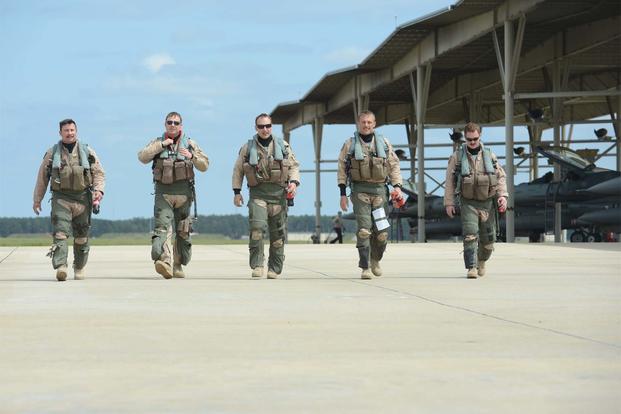The Air Force is still working through how it plans to use the Trump administration's executive order to voluntarily recall up to 1,000 pilots back to active-duty, the head of the service's pilot shortage crisis task force said Monday.
Through Executive Order 13223, signed by President Donald Trump on Friday, the Air Force can now be "focused on getting more authorities in terms of time and numbers," said Brig. Gen. Mike Koscheski, the Air Force Aircrew Crisis Task Force director.
The Air Force doesn't plan to force anyone back on active duty involuntarily any capacity -- even as it finds itself 1,500 pilots short, with the deficit growing, Koscheski said.
"We are an all volunteer force -- that is our focus," Koscheski stressed during a briefing with reporters. Through the order, the Air Force gains "more access to more retirees" through an extended amount of time, he said.
Koscheski said the EO is an addendum of the Voluntary Retired Return to Active Duty, or VRRAD program, instituted by the service in July to welcome back retired pilots into active-duty staff positions.
VRRAD was limited to 25 slots; Now, the service can open the program up to more people over the next three years, and not just for staff positions, but also for instructor positions.
Related content:
- Air Force: No Plans to Recall Retired Pilots to Fix Shortage
- Trump Lets Air Force Recall 1K Retired Pilots
- If You're a Retired Pilot, the Air Force Wants You Back
The authorities were "previously there," Koscheski said, but limited. "Now the numbers are greater." Additionally, "we now have options for a longer assignment cycle," Koscheski said.
He added, "This is going to be a case-by-case basis," Koscheski said. "Every assignment will be a handmade, wooden shoe because it will depend."
The service's latest effort is to help stabilize the growing deficit. Koscheski said Defense Secretary Jim Mattis will institute the final cap number -- likely 1,000, as the Pentagon said on Friday -- but it's unlikely the Air Force will ever reach that potential.
Still Planning Expanded VRRAD
Should the Air Force choose to put an older pilot back in the cockpit, the Air Force will weigh "how long has it been since you last flew that F-16" for example," Koscheski said.
The Air Force currently finds itself 1,500 pilots short, to include 1,300 fighter pilots, the general said.
Through the VRRAD program's first iteration, the Air Force has only had three retirees sign up, he said. About "10 to 15 pilots were interested in the original program" applications, geared toward pilots who held a job in the 11X career field.
Applications were slated to close Dec. 2018. The returning retirees under VRRAD will not be eligible for aviation bonuses. They will deploy only if they volunteer.
Those three that are thus far coming in will be placed in staff positions only, Koscheski said.
Upping Training
An Air Force official told Military.com on Friday that the measure may not be as advantageous as it may seem.
"To recall pilots to active duty, we have a zero sum game ... the training pipeline is finite," the official said.
When asked whether or not the training pipeline could expand for additional pilots, Koscheski said the service is looking into it.
"We are looking to expand the training pipeline -- but again we need a stable budget," he said.
Koscheski said recruitment has not been an issue -- it's the retention and resources to keep pilots trained up, ready, learning and flying that has always been the concern.
"Our long term fix to the pilot crisis is to grow our way out of this and it's going to take a while to get in place what we need to start producing more pilots," he said.
Another initiative the service has repeatedly been trying: bonuses.
The Air Force this summer announced it is increasing its flight incentive pay and aviation bonus programs -- with bonuses of up to $455,000 over 13 years for some fighter pilots.
The latest EO and bulk of initiatives come at a time when the Air Force is losing its pilots to the commercial aviation industry.
Koscheski said leaders are having a tough time catching up with what the airlines can offer monetarily and a more stable lifestyle.
For the military, this is "a crisis because it affect our warfighting because our numbers are low -- when you look at our readiness, obviously our pilot experience and our manning is directly related to our readiness and our combat lethality," Koscheski said.
-- Oriana Pawlyk can be reached at oriana.pawlyk@military.com. Follow her on Twitter at @Oriana0214.




























